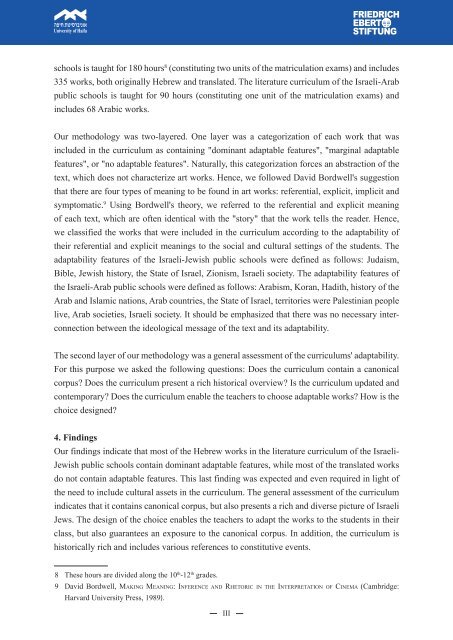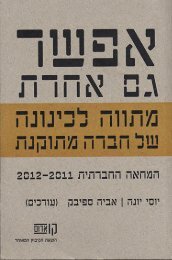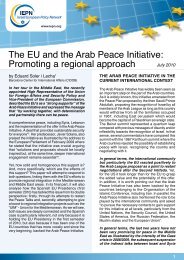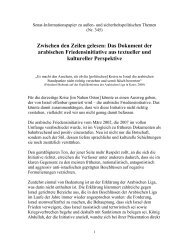ספר×× ××× × ×פ×× - Friedrich-Ebert-Stiftung | Israel
ספר×× ××× × ×פ×× - Friedrich-Ebert-Stiftung | Israel
ספר×× ××× × ×פ×× - Friedrich-Ebert-Stiftung | Israel
You also want an ePaper? Increase the reach of your titles
YUMPU automatically turns print PDFs into web optimized ePapers that Google loves.
schools is taught for 180 hours 8 (constituting two units of the matriculation exams) and includes<br />
335 works, both originally Hebrew and translated. The literature curriculum of the <strong>Israel</strong>i-Arab<br />
public schools is taught for 90 hours (constituting one unit of the matriculation exams) and<br />
includes 68 Arabic works.<br />
Our methodology was two-layered. One layer was a categorization of each work that was<br />
included in the curriculum as containing "dominant adaptable features", "marginal adaptable<br />
features", or "no adaptable features". Naturally, this categorization forces an abstraction of the<br />
text, which does not characterize art works. Hence, we followed David Bordwell's suggestion<br />
that there are four types of meaning to be found in art works: referential, explicit, implicit and<br />
symptomatic. 9 Using Bordwell's theory, we referred to the referential and explicit meaning<br />
of each text, which are often identical with the "story" that the work tells the reader. Hence,<br />
we classified the works that were included in the curriculum according to the adaptability of<br />
their referential and explicit meanings to the social and cultural settings of the students. The<br />
adaptability features of the <strong>Israel</strong>i-Jewish public schools were defined as follows: Judaism,<br />
Bible, Jewish history, the State of <strong>Israel</strong>, Zionism, <strong>Israel</strong>i society. The adaptability features of<br />
the <strong>Israel</strong>i-Arab public schools were defined as follows: Arabism, Koran, Hadith, history of the<br />
Arab and Islamic nations, Arab countries, the State of <strong>Israel</strong>, territories were Palestinian people<br />
live, Arab societies, <strong>Israel</strong>i society. It should be emphasized that there was no necessary interconnection<br />
between the ideological message of the text and its adaptability.<br />
The second layer of our methodology was a general assessment of the curriculums' adaptability.<br />
For this purpose we asked the following questions: Does the curriculum contain a canonical<br />
corpus Does the curriculum present a rich historical overview Is the curriculum updated and<br />
contemporary Does the curriculum enable the teachers to choose adaptable works How is the<br />
choice designed<br />
4. Findings<br />
Our findings indicate that most of the Hebrew works in the literature curriculum of the <strong>Israel</strong>i-<br />
Jewish public schools contain dominant adaptable features, while most of the translated works<br />
do not contain adaptable features. This last finding was expected and even required in light of<br />
the need to include cultural assets in the curriculum. The general assessment of the curriculum<br />
indicates that it contains canonical corpus, but also presents a rich and diverse picture of <strong>Israel</strong>i<br />
Jews. The design of the choice enables the teachers to adapt the works to the students in their<br />
class, but also guarantees an exposure to the canonical corpus. In addition, the curriculum is<br />
historically rich and includes various references to constitutive events.<br />
8 These hours are divided along the 10 th -12 th grades.<br />
9 David Bordwell, Making Meaning: Inference and Rhetoric in the Interpretation of Cinema (Cambridge:<br />
Harvard University Press, 1989(.<br />
III






